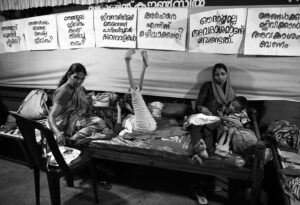The residual toxicity of the pesticide, which is banned all across the world, continues to be a health emergency in the region.

A victim of endosulfan who turned physically challenged. (Photo: Madhuraj)
The residual toxicity of the killer pesticide endosulfan, which was banned globally about 18 years ago, is raising fresh concerns in certain rural areas spread in the Kasargod district of Kerala and Dakshina Kannada district of Karnataka.
This has prompted the National Green Tribunal (NGT) to investigate the matter.
As directed by the Southern Bench of the NGT, Pollution Control Board (PCB) officials from the neighbouring states and the Centre collected soil and water samples from the Minjipadavu village on the northernmost edge of Kerala’s Kasargod district last week.
As per the complaint received by the NGT, officials and workers of the public sector Plantation Corporation of Kerala (PCK) disposed of huge amounts of the persistent organic pollutant in an unused well in the village two years before the enforcement of the global ban on its manufacturing and application in agricultural farms.
Going by the official estimates, the aerial spraying of the banned pesticide on cashew plantations under the PCK in Kasargod killed over 500 people, apart from maiming 6,728 others who lived in the close vicinity of the plantations.

Victims of endosulfan at a recent protest in Kasaragod. Photo: Madhuraj
Noted environmentalist Ravindranath Shanbhogue, who also heads the Udupi-based Human Rights Protection Foundation, told South First that the latest NGT action was based on his intervention through a petition.
He said he hoped that the soil and water testing results would come out soon, prompting appropriate actions to resolve the residual toxicity of endosulfan prevailing alarmingly in the village and its surroundings.
According to him, the groundwater and soil in Minchipadavu have remained contaminated for a long time.
Now, the pollutant was extending the doom: It could spread to areas beyond the interstate border.
The Nettanige Mudoor Grama Panchayat of Karnataka, located hardly 500 metres away from Minchipadavu, is now facing contamination from over 6,000 litres of the canned poisonous stuff dumped in the abandoned well.
A bench of the NGT’s Southern Zone in Chennai took up the petition on 20 December, and soon its judicial member Justice Pushpa Sathyanarayanan and expert member Satyagopal Korlapati served notices to the Union government, the state governments of Kerala and Karnataka, the three pollution control boards, and the Kerala government-controlled PCK, which is headquartered in Kottayam.
The NGT will hear further on the case on 2 January. The two states and the Centre conducted the joint collection of water and soil for testing as per the instruction to file reports after making a spot inspection.
J Chandra Babu, the Bengaluru regional director of the Central PCB, led the expert team that collected the samples.
They comprised a member from the Central PCB, five from the state PCB and Health Department of Karnataka, and two from the Kerala PCB.
They gathered water and soil samples from the locality during the third week of December and sent them for testing.
To determine whether endosulfan was seeping through the ground, they drilled 30-40 feet and took soil and groundwater samples.
The group also visited the work sheds and the PCK office in the local cashew estate of the PSU, which is now defunct.
On its cashew nut plantations in the Kasragod district, the PCK began using endosulfan, an organochlorine pesticide, on a test basis in 1978 to eradicate tea mosquito pests.
In 1978, the state-run Plantation Corporation of Kerala began spraying endosulfan on its cashew nut crops in the Kasaragod area to remove tea mosquito bugs.

Endosulfan victims and their relatives on a protest in Kasargod. Photo By Madhuraj.
The PCK began legally but unscientifically spraying endosulfan from helicopters in 1981 on its plantations, which are distributed across 11 gram panchayats in the district. The aerial spraying programme was discontinued in 2001.
Until 2001, the pesticide was sprayed from the air twice or three times a year. Its use was proclaimed illegal in October 2005. Even before the ban, restrictions were in place.
After conducting extensive research, a government-appointed Kerala Agriculture University (KAU) committee advised an immediate halt to aerial spraying and pesticide use in Kasargod plantations in February 2001.
Meanwhile, PCK General Manager Justus Karuna Rajan, located in Kottayam, told South First that the petition was a pack of “fabricated lies”, and that the company never disposed of endosulfan in wells and other public utilities.
When endosulfan was banned, the remaining stocks were stored in locked godowns in Periya, Rajapuram, and Cheemeni in the Kasargod district and Mannarkkad in Palakkad district, and the keys were with the district administrations, added the official.
“The stocks are still lying in the godowns and have not been disposed of yet,” he stated.
According to the official, the PCK will inform the NGT of the “facts” on 2 January.
However, activists say the pesticide-dumping in the well happened about two years before the global ban, when the people’s movement against the killer pesticide was high in Kasargod.
The people’s movement forcibly prevented the aerial spraying and created awareness among the residents. So, the PCK disposed of such a huge amount of the pesticide in the abandoned well, they said.
Shanbhogue informed South First that Achutha Maniyani, a former security guard for the PCK, disclosed the shocking dumping of the lethal pesticide in the well.
About 15 years ago, Maniyani spoke about it for the first time in the acclaimed documentary film on endosulfan victims by academic-turned-filmmaker MA Rahman, titled A Paradise for the Dying.
Maniyani said in the documentary that the PCK abandoned huge endosulfan stocks in a well inside the cashew estate at Minchipadavu. He has been repeatedly saying this to journalists and experts since 2013.
An independent member of the Minchipadavu ward of Karadka Grama Panchayat named K Venugopala claimed that the endosulfan was dumped in aluminium and plastic cans and hidden in the 40-foot-deep well.
Shanbhogue said that the endosulfan was dumped illegally and carelessly in the hilly area of Minchinpadavu in the Kasargod district of Kerala, which is close to Nettanige-Mudnur village in Karnataka.
According to Shanbhogue, endosulfan was detected in water samples taken from Nettinanige Mudnur, located downhill from Minchinapadvu, by Dakshina Kannada district officials.
A total of 36 endosulfan victims were discovered in Nettanige Mudnur and the nearby villages of Padvannor and Badagannur.
Since endosulfan has not been sprayed in these villages, there is great fear that endosulfan that has been purportedly deposited in Kerala’s Minchinapadavu hillocks may have gotten into the groundwater and impacted the residents in Dakshina Kannada.

A child victim of the aerial spraying of endosulfan. (Madhuraj)
To facilitate the safe and secure extraction of endosulfan cans from the abandoned well in the Minchinapadavu hillocks, Shanbhogue has requested instructions from the NGT to the Kerala government.
Additionally, he has asked the Karnataka and Kerala PCBs for guidance on conducting groundwater analyses in the villages bordering Nethanagi village in Kasaragod district on the Karnataka-Kerala border.
The National Institute of Occupational Health published a study in January 2002 that discovered endosulfan contamination in the area’s water and blood samples gathered from the affected villages.
According to the study, the exposed populations had a higher chance of congenital malformations, low IQ, slow learning, learning difficulty, early menarche in girls, and delayed puberty in boys.
Currently, around 6,600 people are listed on the government’s registry of endosulfan victims. Over 500 have already died.
Close relatives of the victims, who have physical and mental defects, are still suffering from stress and anxiety.
Social activists who work with them have observed suicidal tendencies among the relatives of endosulfan-affected people.
The residual effects of the deadly insecticides are still visible despite the global ban. Children are still born with swollen heads as a result of hydrocephalus (an abnormal accumulation of cerebrospinal fluid), as well as other physical abnormalities and mental issues.
Cancer, cerebral palsy, skin ailments, and vision loss are also widespread among the population of Kasaragod, Kerala’s poorest district.
According to studies by the Kerala State Council for Science, Technology, and Environment, endosulfan remains prevalent in the soil and sediments at waterbodies in and around the corporation’s estates.

Jul 26, 2024

Jul 26, 2024

Jul 26, 2024

Jul 26, 2024

Jul 26, 2024

Jul 26, 2024